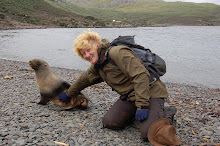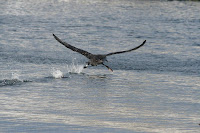 King penguins don't breed here. They come to moult (and look really scruffy) in the summer, so when they turn up in winter, they are more photogenic!
King penguins don't breed here. They come to moult (and look really scruffy) in the summer, so when they turn up in winter, they are more photogenic!
 A chinstrap penguin - these breed in large numbers elsewhere around South Georgia and the South Sandwich Islands, and further south in the Antarctic, but not on Bird Island
A chinstrap penguin - these breed in large numbers elsewhere around South Georgia and the South Sandwich Islands, and further south in the Antarctic, but not on Bird IslandIn addition to the longer, dry and sunny days, we had some great wildlife encounters. Around the beginning of the month, upwards of 12 snow petrels could be regularly seen in the bays around the island. These have never been confirmed as breeding on Bird Island, and most sightings are fleeting glimpses as the birds fly past, out at sea. But seeing these beautiful, pure white birds at close quarters is something special, and sometimes we have to stop and think how lucky we are to see them like this.
We have also seen quite a number of chinstrap penguins. They used to breed on Bird Island in a small colony on Johnson Beach, but this disappeared several years ago. Now and again, a pair attempts to breed amongst the 80,000 macaroni penguins on Goldcrest Point, but otherwise, we class them as 'visitors' rather than 'residents'. During August and early September we have seen quite a few chinstraps. They look very smart, and although not as tall as our numerous gentoo penguins, they seem to have an very long tail!
The wandering albatross chicks are still on their nests, although they are starting to look more like birds now, as their dark feathers grow through the grey down. They will start to leave the island at the end of November, nearly one year on from their parents arriving to breed.























































